A Decision Framework for Identifying Methods to Construct Stable Composite Indicators That Capture the Concept of Multidimensional Social Phenomena: The Case of Social Exclusion
Abstract
:1. Introduction
2. Literature Review
2.1. Multidimensional Social Exclusion
2.2. Methods for Constructing Composite Indicators from a Geographic Perspective
3. Materials and Methods
3.1. Study Area: Medium-Sized Cities of the State of Paraná, Brazil
3.2. Theoretical Framework: Multidimensional Social Exclusion Sub-Indicators
3.3. Operational Framework: Construction and Performance Analysis of Composite Indicators
4. Results and Analysis
5. Discussion of the Results
6. Conclusions
Author Contributions
Funding
Institutional Review Board Statement
Informed Consent Statement
Data Availability Statement
Conflicts of Interest
References
- Levitas, R. What is social exclusion. In Breadline Europe: The Measurement of Poverty; Policy Press: Bristol, UK, 2000; pp. 357–383. [Google Scholar]
- Nardo, M.; Saisana, M.; Saltelli, A.; Tarantola, S. Tools for Composite Indicators Building; European Commission, Institute for the Protection and Security of the Citizen, JRC: Ispra, Italy, 2005; p. 133. [Google Scholar]
- Kuc-Czarnecka, M.; Lo Piano, S.; Saltelli, A. Quantitative storytelling in the making of a composite indicator. Soc. Indic. Res. 2020, 149, 775–802. [Google Scholar] [CrossRef] [Green Version]
- Dialga, I.; Le Giang, T.H. Highlighting methodological limitations in the steps of composite indicators construction. Soc. Indic. Res. 2017, 131, 441–465. [Google Scholar] [CrossRef]
- Greco, S.; Ishizaka, A.; Tasiou, M.; Torrisi, G. On the methodological framework of composite indices: A review of the issues of weighting, aggregation, and robustness. Soc. Indic. Res. 2019, 141, 61–94. [Google Scholar] [CrossRef] [Green Version]
- Cinelli, M.; Spada, M.; Kim, W.; Zhang, Y.; Burgherr, P. MCDA Index Tool: An interactive software to develop indices and rankings. Environ. Syst. Decis. 2021, 41, 82–109. [Google Scholar] [CrossRef] [PubMed]
- Dangschat, J.S. Space matters—Marginalization and its places. Int. J. Urban Reg. Res. 2009, 33, 835–840. [Google Scholar] [CrossRef]
- Stanković, J.J.; Džunić, M.; Marjanović, I. Towards an Inclusive Europe: Ranking European Countries Based on Social Sustainability Indicators. In Decision Support Systems XII: Decision Support Addressing Modern Industry, Business, and Societal Needs, Proceedings of the 8th International Conference on Decision Support System Technology, ICDSST 2022, Thessaloniki, Greece, 23–25 May 2022; Springer International Publishing: Cham, Switzerland, 2022; pp. 84–96. [Google Scholar]
- Malisa, A. Persistence of Social Exclusion in Tanzania. In Efficiency, Equity and Well-Being in Selected African Countries; Springer: Cham, Switzerland, 2019; pp. 97–120. [Google Scholar]
- García-Vélez, D.F.; Contreras-Jaramillo, M.A.; Torres-Gutiérrez, T.P.; Correa-Quezada, R.F. Social exclusion in Ecuador with housing indicators: A regional analysis. In Entrepreneurship and the Community: A Multidisciplinary Perspective on Creativity, Social Challenges, and Business; Springer: Cham, Switzerland, 2020; pp. 159–176. [Google Scholar]
- Bhalla, A.; Lapeyre, F. Social exclusion: Towards an analytical and operational framework. Dev. Change 1997, 28, 413–433. [Google Scholar] [CrossRef]
- Hübelová, D.; Ptáček, P.; Šlechtová, T. Demographic and socio-economic factors influencing health inequalities in the Czech Republic. GeoScape 2021, 15, 53–65. [Google Scholar] [CrossRef]
- Xiao, R.; Wang, G.; Wang, M. Transportation disadvantage and neighborhood sociodemographics: A composite indicator approach to examining social inequalities. Soc. Indic. Res. 2018, 137, 29–43. [Google Scholar] [CrossRef]
- Rogge, N.; Self, R. Measuring regional social inclusion performances in the EU: Looking for unity in diversity. J. Eur. Soc. Policy 2019, 29, 325–344. [Google Scholar] [CrossRef]
- Abello, A.; Gong, C.H.; Daly, A.; McNamara, J. Spatial dimensions of child social exclusion risk in Australia: Widening the scope. Child Indic. Res. 2012, 5, 685–703. [Google Scholar] [CrossRef]
- Mohanty, I.; Edvardsson, M.; Abello, A.; Eldridge, D. Child social exclusion risk and child health outcomes in Australia. PLoS ONE 2016, 11, e0154536. [Google Scholar] [CrossRef] [Green Version]
- Keogh, S.; O’Neill, S.; Walsh, K. Composite measures for assessing multidimensional social exclusion in later life: Conceptual and methodological challenges. Soc. Indic. Res. 2021, 155, 389–410. [Google Scholar] [CrossRef]
- Leung, A.; Burke, M.; Cui, J. The tale of two (very different) cities–Mapping the urban transport oil vulnerability of Brisbane and Hong Kong. Transp. Res. Part D Transp. Environ. 2018, 65, 796–816. [Google Scholar] [CrossRef] [Green Version]
- El Gibari, S.; Gómez, T.; Ruiz, F. Building composite indicators using multicriteria methods: A review. J. Bus. Econ. 2019, 89, 1–24. [Google Scholar] [CrossRef]
- Węziak-Białowolska, D. Poverty in the regions of the European Union–measurement with a composite indicator. Contemp. Econ. 2015, 9, 113–154. [Google Scholar] [CrossRef] [Green Version]
- Correa Machado, A.M.; Ekel, P.I.; Libório, M.P. Goal-based participatory weighting scheme: Balancing objectivity and subjectivity in the construction of composite indicators. Qual. Quant. 2022, 1–21. [Google Scholar] [CrossRef]
- Tickamyer, A.R. Space matters! Spatial inequality in future sociology. Contemp. Sociol. 2000, 29, 805–813. [Google Scholar] [CrossRef]
- Stretesky, P.B.; Schuck, A.M.; Hogan, M.J. Space matters: An analysis of poverty, poverty clustering, and violent crime. Justice Q. 2004, 21, 817–841. [Google Scholar] [CrossRef]
- Emrich, C.T.; Cutter, S.L. Social vulnerability to climate-sensitive hazards in the southern United States. Weather Clim. Soc. 2011, 3, 193–208. [Google Scholar] [CrossRef]
- Schwanen, T.; Wang, D. Well-being, context, and everyday activities in space and time. Ann. Assoc. Am. Geogr. 2014, 104, 833–851. [Google Scholar] [CrossRef]
- Tate, E. Uncertainty analysis for a social vulnerability index. Ann. Assoc. Am. Geogr. 2013, 103, 526–543. [Google Scholar] [CrossRef]
- Peiró-Palomino, J.; Picazo-Tadeo, A.J. OECD: One or many? Ranking countries with a composite well-being indicator. Soc. Indic. Res. 2018, 139, 847–869. [Google Scholar] [CrossRef]
- Rabiei-Dastjerdi, H.; Matthews, S.A. Who gets what, where, and how much? Composite index of spatial inequality for small areas in Tehran. Reg. Sci. Policy Pract. 2021, 13, 191–205. [Google Scholar] [CrossRef]
- Drago, C. The analysis and the measurement of poverty: An interval-based composite indicator approach. Economies 2021, 9, 145. [Google Scholar] [CrossRef]
- Rabiei-Dastjerdi, H.; Matthews, S.A.; Ardalan, A. Measuring spatial accessibility to urban facilities and services in Tehran. Spat. Demogr. 2018, 6, 17–34. [Google Scholar] [CrossRef]
- Müller-Frączek, I. Dynamic measurement of complex phenomena in assessing the Europe 2020 strategy effects. Reg. Stat. 2019, 9, 32–53. [Google Scholar] [CrossRef]
- Hübelová, D.; Kozumplíková, A.; Rousová, G. Relationship of socio-demographic indicators and mortality structure in districts of the south Moravian region (Czech Republic) in 2006 and 2015. Geogr. Inf. 2019, 22, 150–162. [Google Scholar]
- Edina, K.D.; Tamás, M.; Katalin, M.B. The indicator-based measurement of the circular economy in the countries of the European Union. Tér És Társadalom 2022, 36, 49–69. [Google Scholar]
- Bell, D.; Burns, L. Creating a Composite Index to Target Recruitment of UK Students from Areas of Low Participation in Higher Education. Appl. Spat. Anal. Policy 2021, 15, 847–872. [Google Scholar] [CrossRef]
- Libório, M.P.; Ekel, P.Y.; Martinuci, O.D.S.; Figueiredo, L.R.; Hadad, R.M.; Lyrio, R.D.M.; Bernardes, P. Fuzzy set based intra-urban inequality indicator. Qual. Quant. 2022, 56, 667–687. [Google Scholar] [CrossRef]
- Libório, M.P.; Martinuci, O.D.S.; Machado, A.M.C.; Hadad, R.M.; Bernardes, P.; Camacho, V.A.L. Adequacy and consistency of an intraurban inequality indicator constructed through principal component analysis. Prof. Geogr. 2021, 73, 282–296. [Google Scholar] [CrossRef]
- Greco, S.; Ishizaka, A.; Matarazzo, B.; Torrisi, G. Stochastic multi-attribute acceptability analysis (SMAA): An application to the ranking of Italian regions. Reg. Stud. 2018, 52, 585–600. [Google Scholar] [CrossRef] [Green Version]
- Cartone, A.; Panzera, D. Deprivation at local level: Practical problems and policy implications for the province of Milan. Reg. Sci. Policy Pract. 2021, 13, 43–61. [Google Scholar] [CrossRef]
- Libório, M.P.; Martinuci, O.D.S.; Machado, A.M.C.; Ekel, P.I.; Abreu, J.F.D.; Laudares, S. Representing Multidimensional Phenomena of Geographic Interest: Benefit of the Doubt or Principal Component Analysis? Prof. Geogr. 2022, 74, 758–771. [Google Scholar] [CrossRef]
- Libório, M.P.; Martinuci, O.D.S.; Ekel, P.I.; Hadad, R.M.; Lyrio, R.D.M.; Bernardes, P. Measuring inequality through a non-compensatory approach. GeoJournal 2021, 87, 4689–4706. [Google Scholar] [CrossRef]
- Libório, M.P.; Silva, L.M.L.; Ekel, P.I.; Figueiredo, L.R.; Bernardes, P. Consensus-Based Sub-Indicator Weighting Approach: Constructing Composite Indicators Compatible with Expert Opinion. Soc. Indic. Res. 2022, 164, 1073–1099. [Google Scholar] [CrossRef]
- Bernardes, P.; Ekel, P.I.; Rezende, S.F.L.; Pereira Júnior, J.G.; dos Santos, A.C.G.; da Costa, M.A.R.; Carvalhais, R.L.; Libório, M.P. Cost of doing business index in Latin America. Qual. Quant. 2022, 56, 2233–2252. [Google Scholar] [CrossRef]
- Mazziotta, M.; Pareto, A. Use and misuse of PCA for measuring well-being. Soc. Indic. Res. 2019, 142, 451–476. [Google Scholar] [CrossRef]
- Fusco, E.; Vidoli, F.; Sahoo, B.K. Spatial heterogeneity in composite indicator: A methodological proposal. Omega 2018, 77, 1–14. [Google Scholar] [CrossRef]
- Liern, V.; Pérez-Gladish, B. Building composite indicators with unweighted-TOPSIS. IEEE Trans. Eng. Manag. 2021, 70, 1871–1880. [Google Scholar] [CrossRef]
- Silva, O. Mapeamento e Análise das Desigualdades Territoriais em Cidades de Porte Médio do Interior do Paraná; Project Report: CNPq: Edital Universal 01/2016; Processo 423443/2016-0; Universisdade Estadual de Maringá: Maringá, Brazil, 2021; Available online: https://drive.google.com/drive/folders/1VDuedzuoTBkOfkyXnegUkHv90yLz7Mrf?usp=sharing (accessed on 27 March 2022).
- IBGE. Censo Demográfico; Insituto Brasileiro de Geografia e Estatística: Rio de Janeiro, Brazil, 2010. [Google Scholar]
- Melazzo, E.S. Notas sobre um Grupo de Pesquisas—O Centro de Estudos e Mapeamento da Exclusão Social para Políticas Públicas–CEMESPP. Cad. Prudentino Geogr. 2019, 2, 133–140. [Google Scholar]
- Kowalski, C.J. On the effects of non-normality on the distribution of the sample product-moment correlation coefficient. J. R. Stat. Soc. Ser. C (Appl. Stat.) 1972, 21, 1–12. [Google Scholar] [CrossRef]
- Hinkle, D.E.; Wiersma, W.; Jurs, S.G. Applied Statistics for the Behavioral Sciences; Houghton Mifflin College Division: Boston, MA, USA, 2003; Volume 663. [Google Scholar]
- Mazziotta, M.; Pareto, A. Synthesis of indicators: The composite indicators approach. In Complexity in Society: From Indicators Construction to Their Synthesis; Springer: Cham, Switzerland, 2017; pp. 159–191. [Google Scholar]
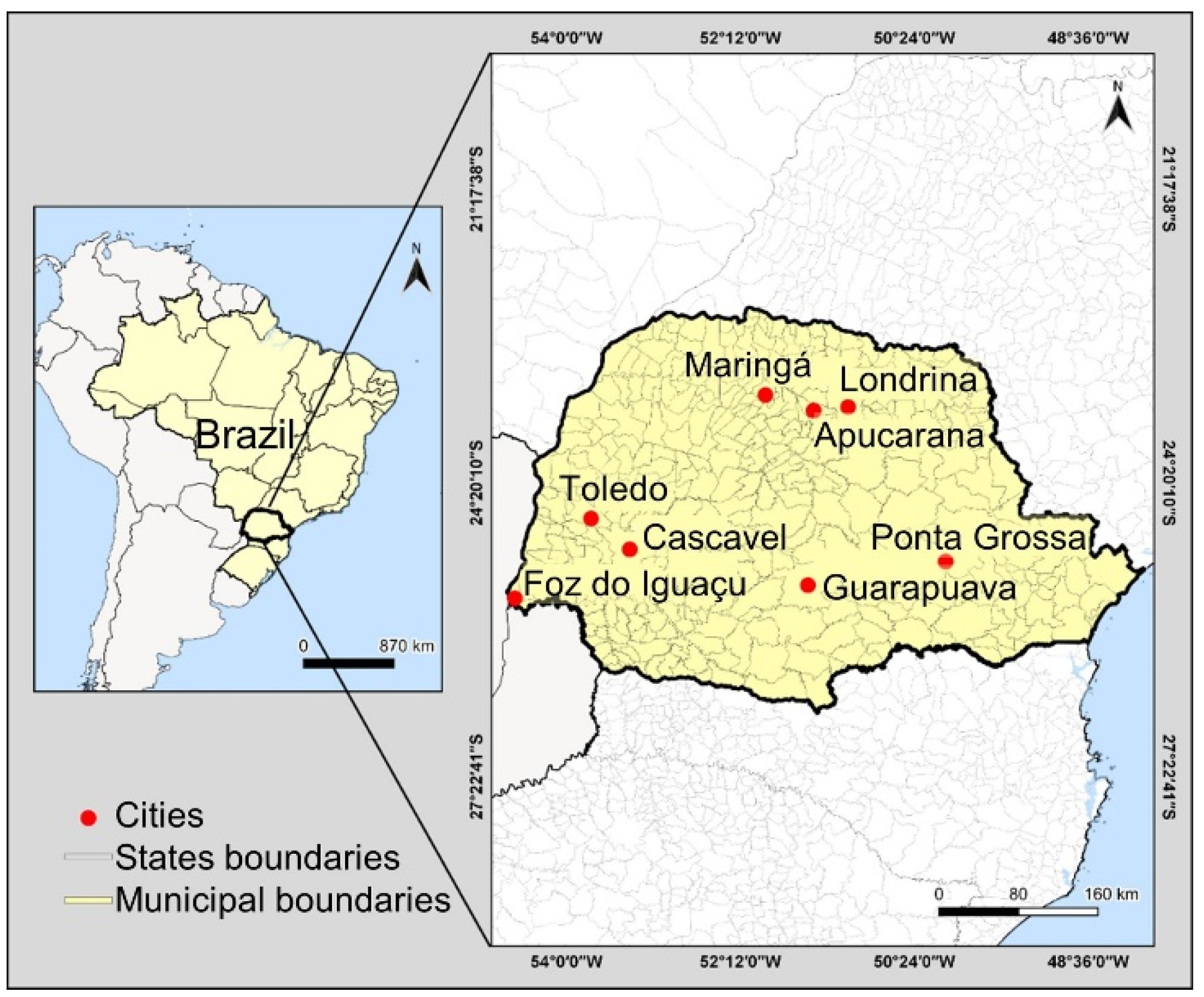
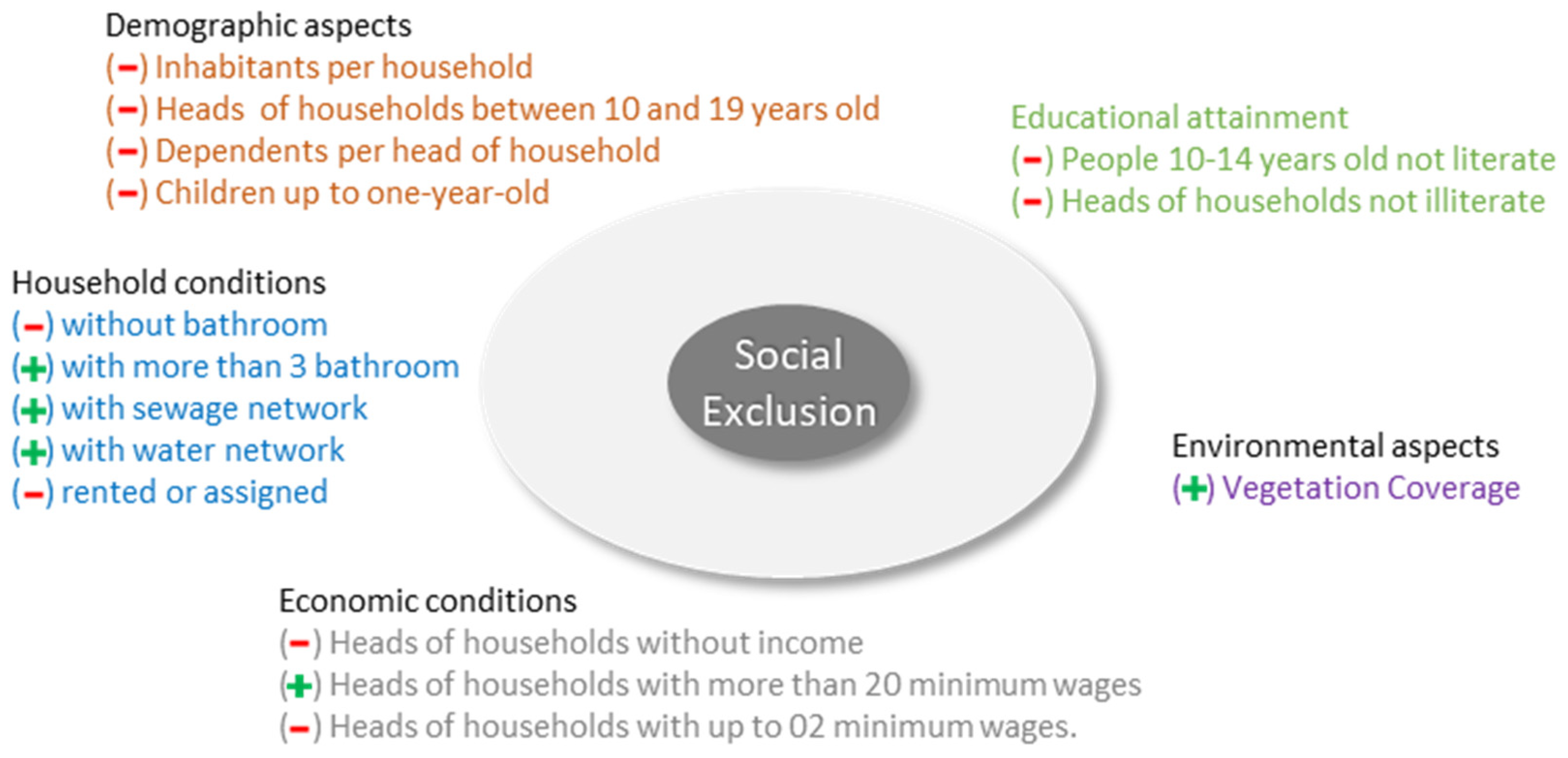

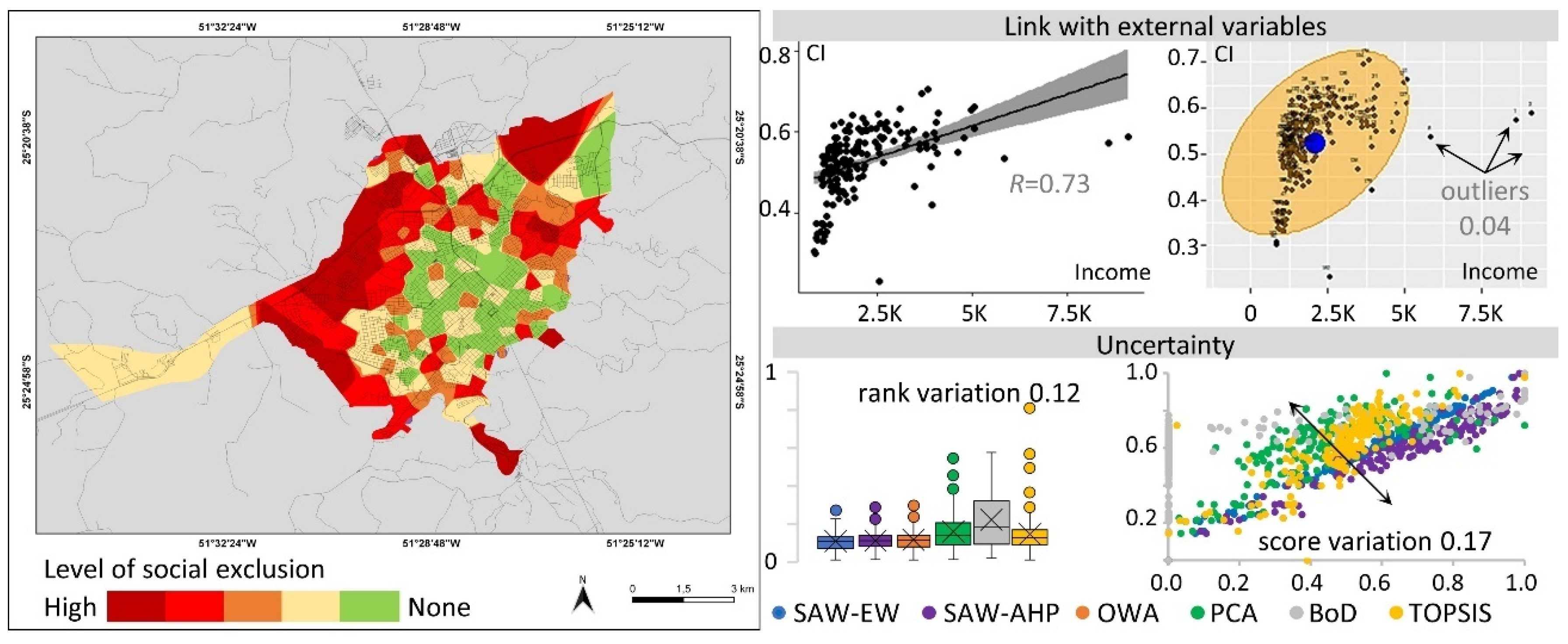

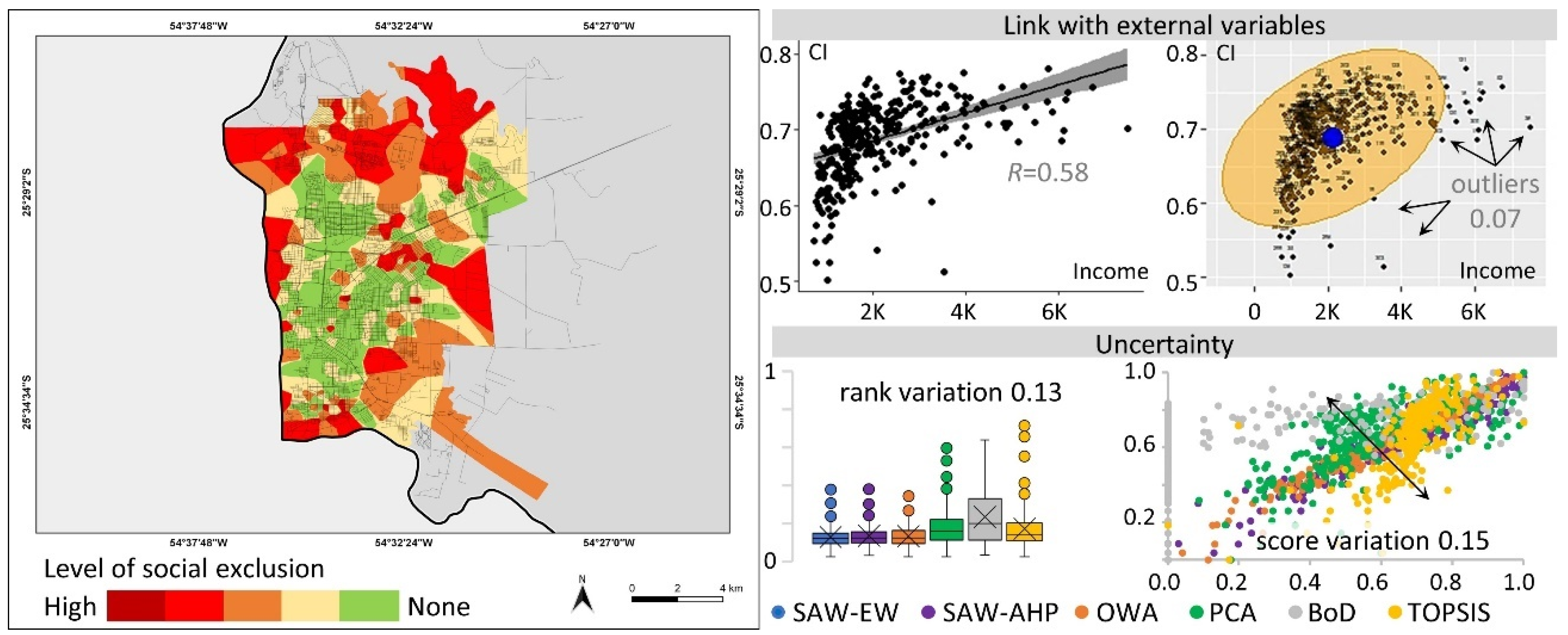

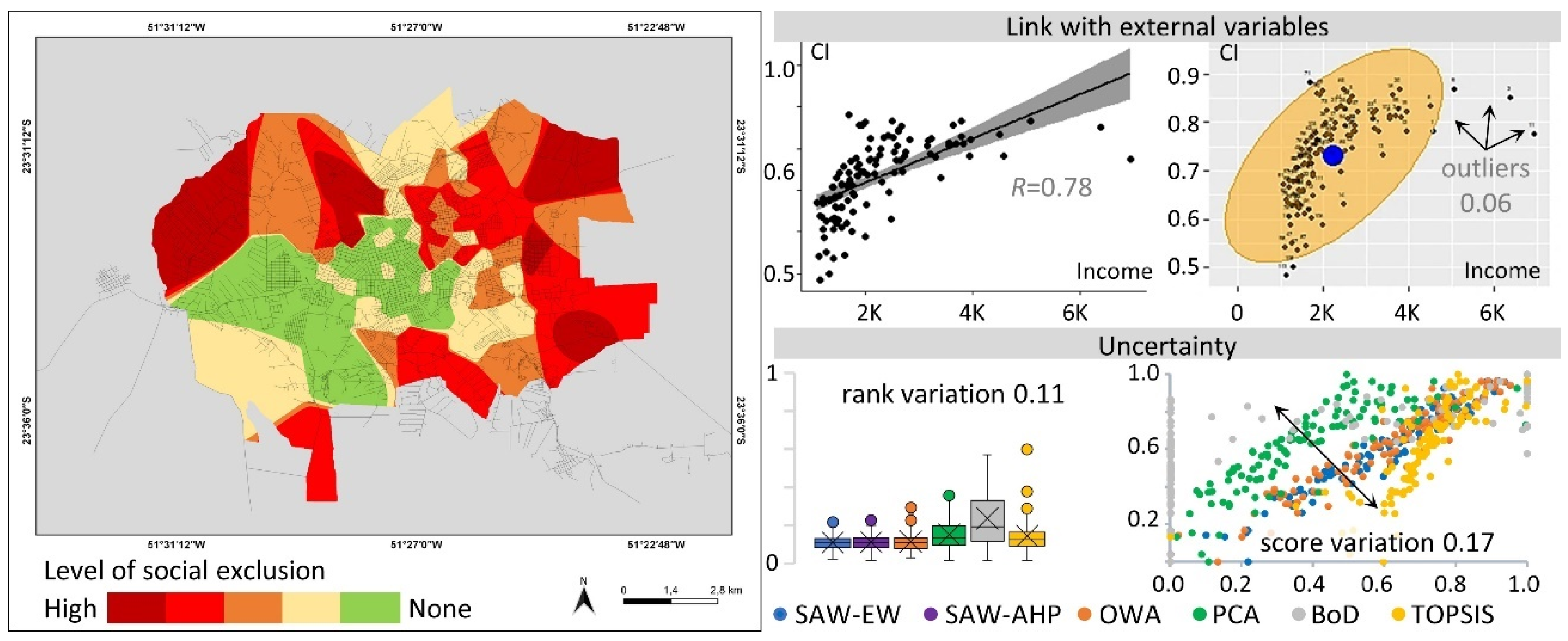
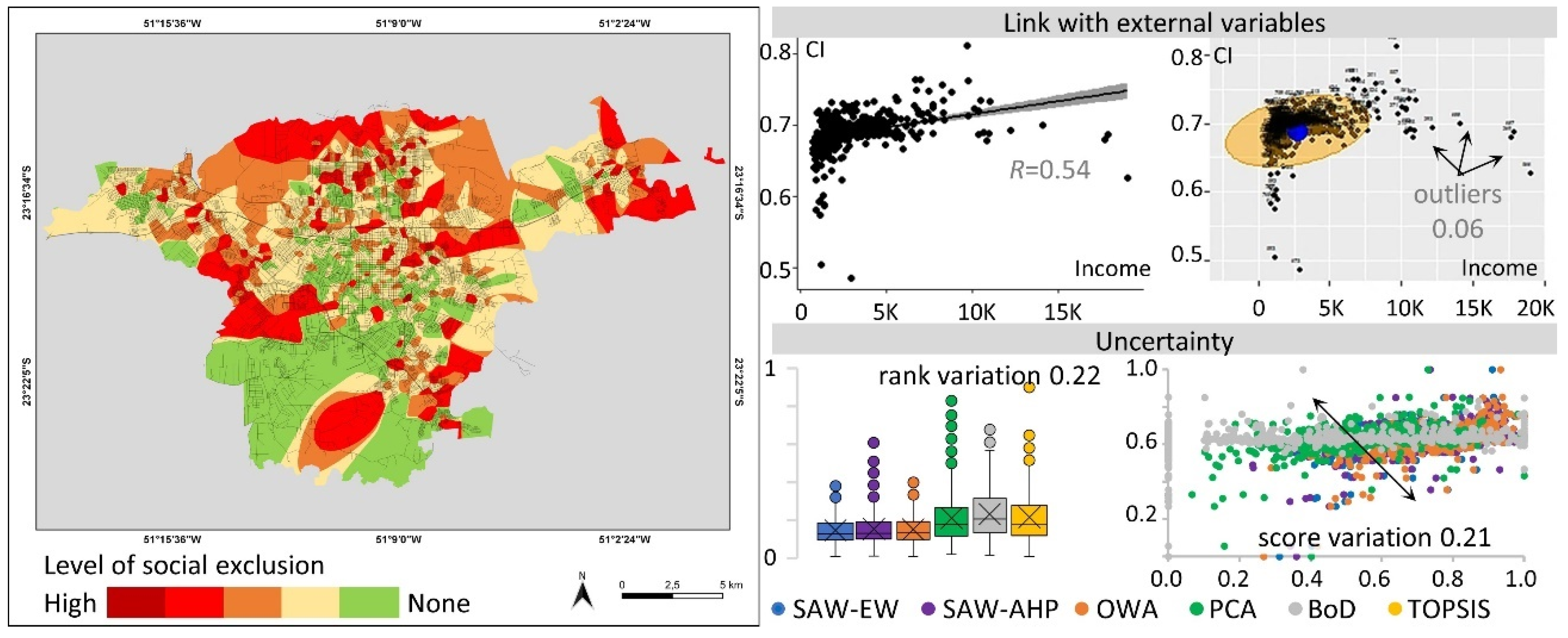
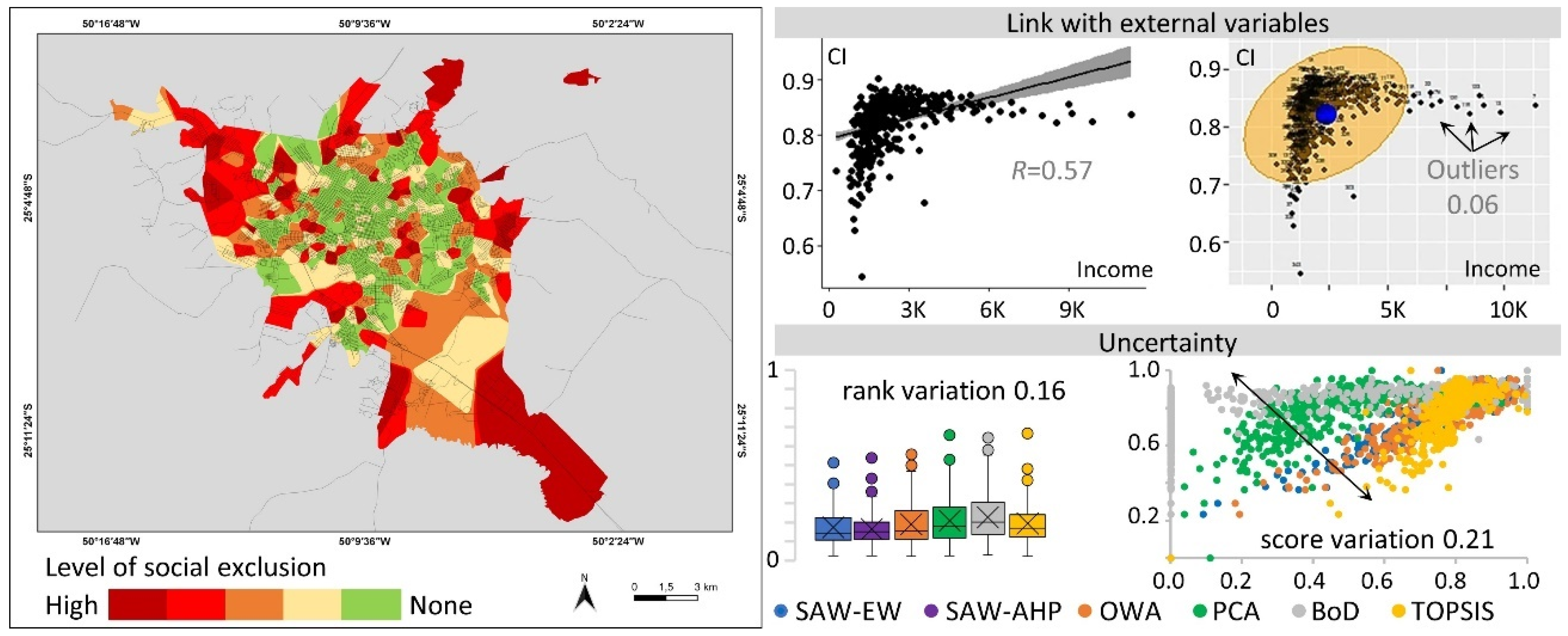
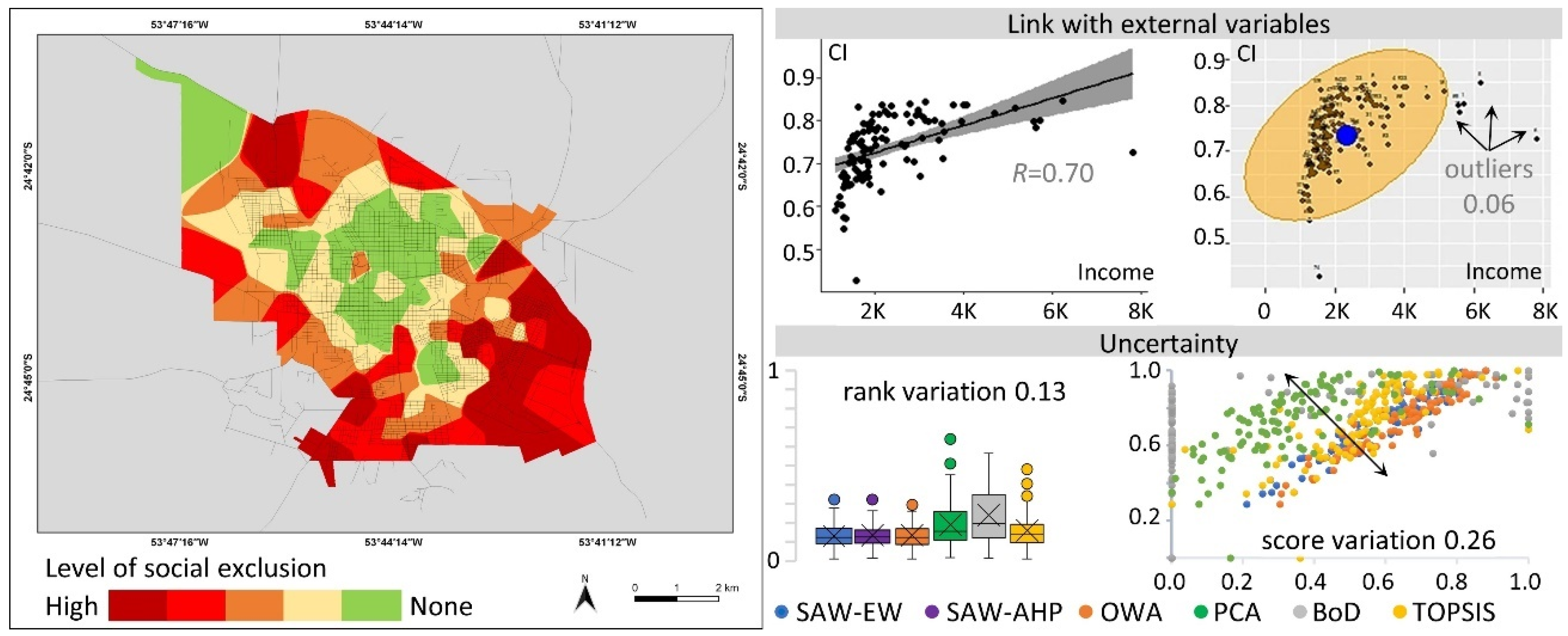
| Mid-Sized Cities | SAW-EW | SAW-PW | OWA | PCA | BoD | TOPSIS |
|---|---|---|---|---|---|---|
| Apucarana | 0.74 | 0.78 | 0.75 | 0.92 | 0.39 | 0.73 |
| Cascavel | 0.58 | 0.58 | 0.58 | 0.77 | 0.37 | 0.45 |
| Foz do Iguaçu | 0.58 | 0.61 | 0.58 | 0.90 | 0.47 | 0.68 |
| Guarapuava | 0.66 | 0.80 | 0.73 | 0.93 | 0.55 | 0.65 |
| Londrina | 0.39 | 0.56 | 0.37 | 0.89 | 0.34 | 0.54 |
| Maringá | 0.81 | 0.78 | 0.81 | 0.88 | 0.60 | 0.75 |
| Ponta Grossa | 0.23 | 0.57 | 0.15 | 0.90 | 0.45 | 0.72 |
| Toledo | 0.62 | 0.70 | 0.60 | 0.90 | 0.40 | 0.61 |
| Average | 0.58 | 0.67 | 0.57 | 0.89 | 0.45 | 0.64 |
| Mid-Sized Cities | SAW-EW | SAW-PW | OWA | PCA | BoD | TOPSIS |
|---|---|---|---|---|---|---|
| Apucarana | 0.06 | 0.06 | 0.06 | 0.06 | 0.04 | 0.04 |
| Cascavel | 0.06 | 0.07 | 0.06 | 0.07 | 0.09 | 0.09 |
| Foz do Iguaçu | 0.07 | 0.08 | 0.08 | 0.08 | 0.07 | 0.07 |
| Guarapuava | 0.05 | 0.06 | 0.04 | 0.05 | 0.04 | 0.05 |
| Londrina | 0.06 | 0.06 | 0.06 | 0.06 | 0.04 | 0.06 |
| Maringá | 0.06 | 0.06 | 0.06 | 0.08 | 0.10 | 0.07 |
| Ponta Grossa | 0.06 | 0.06 | 0.07 | 0.06 | 0.06 | 0.06 |
| Toledo | 0.08 | 0.06 | 0.07 | 0.07 | 0.06 | 0.08 |
| Average | 0.06 | 0.06 | 0.06 | 0.07 | 0.06 | 0.07 |
| Mid-Sized Cities | SAW-EW | SAW-PW | OWA | PCA | BoD | TOPSIS |
|---|---|---|---|---|---|---|
| Apucarana | 0.11 | 0.11 | 0.11 | 0.15 | 0.24 | 0.14 |
| Cascavel | 0.14 | 0.15 | 0.15 | 0.20 | 0.26 | 0.26 |
| Foz do Iguaçu | 0.13 | 0.14 | 0.13 | 0.18 | 0.23 | 0.17 |
| Guarapuava | 0.11 | 0.11 | 0.12 | 0.16 | 0.22 | 0.15 |
| Londrina | 0.15 | 0.15 | 0.15 | 0.21 | 0.23 | 0.22 |
| Maringá | 0.12 | 0.12 | 0.12 | 0.16 | 0.27 | 0.16 |
| Ponta Grossa | 0.17 | 0.16 | 0.19 | 0.21 | 0.23 | 0.19 |
| Toledo | 0.13 | 0.13 | 0.13 | 0.19 | 0.24 | 0.16 |
| Average | 0.13 | 0.13 | 0.14 | 0.18 | 0.24 | 0.18 |
| Mid-Sized Cities | SAW-EW | SAW-PW | OWA | PCA | BoD | TOPSIS |
|---|---|---|---|---|---|---|
| Apucarana | 0.16 | 0.17 | 0.16 | 0.27 | 0.37 | 0.24 |
| Cascavel | 0.18 | 0.20 | 0.17 | 0.25 | 0.48 | 0.23 |
| Foz do Iguaçu | 0.15 | 0.16 | 0.15 | 0.19 | 0.43 | 0.19 |
| Guarapuava | 0.16 | 0.21 | 0.17 | 0.20 | 0.37 | 0.18 |
| Londrina | 0.19 | 0.20 | 0.19 | 0.25 | 0.46 | 0.21 |
| Maringá | 0.16 | 0.21 | 0.15 | 0.17 | 0.37 | 0.17 |
| Ponta Grossa | 0.19 | 0.21 | 0.20 | 0.32 | 0.47 | 0.22 |
| Toledo | 0.19 | 0.26 | 0.19 | 0.29 | 0.39 | 0.21 |
| Average | 0.17 | 0.20 | 0.17 | 0.24 | 0.42 | 0.21 |
Disclaimer/Publisher’s Note: The statements, opinions and data contained in all publications are solely those of the individual author(s) and contributor(s) and not of MDPI and/or the editor(s). MDPI and/or the editor(s) disclaim responsibility for any injury to people or property resulting from any ideas, methods, instructions or products referred to in the content. |
© 2023 by the authors. Licensee MDPI, Basel, Switzerland. This article is an open access article distributed under the terms and conditions of the Creative Commons Attribution (CC BY) license (https://creativecommons.org/licenses/by/4.0/).
Share and Cite
Libório, M.P.; Diniz, A.M.A.; Rabiei-Dastjerd, H.; Martinuci, O.d.S.; Martins, C.A.P.d.S.; Ekel, P.I. A Decision Framework for Identifying Methods to Construct Stable Composite Indicators That Capture the Concept of Multidimensional Social Phenomena: The Case of Social Exclusion. Sustainability 2023, 15, 6171. https://doi.org/10.3390/su15076171
Libório MP, Diniz AMA, Rabiei-Dastjerd H, Martinuci OdS, Martins CAPdS, Ekel PI. A Decision Framework for Identifying Methods to Construct Stable Composite Indicators That Capture the Concept of Multidimensional Social Phenomena: The Case of Social Exclusion. Sustainability. 2023; 15(7):6171. https://doi.org/10.3390/su15076171
Chicago/Turabian StyleLibório, Matheus Pereira, Alexandre Magno Alves Diniz, Hamidreza Rabiei-Dastjerd, Oseias da Silva Martinuci, Carlos Augusto Paiva da Silva Martins, and Petr Iakovlevitch Ekel. 2023. "A Decision Framework for Identifying Methods to Construct Stable Composite Indicators That Capture the Concept of Multidimensional Social Phenomena: The Case of Social Exclusion" Sustainability 15, no. 7: 6171. https://doi.org/10.3390/su15076171
APA StyleLibório, M. P., Diniz, A. M. A., Rabiei-Dastjerd, H., Martinuci, O. d. S., Martins, C. A. P. d. S., & Ekel, P. I. (2023). A Decision Framework for Identifying Methods to Construct Stable Composite Indicators That Capture the Concept of Multidimensional Social Phenomena: The Case of Social Exclusion. Sustainability, 15(7), 6171. https://doi.org/10.3390/su15076171






